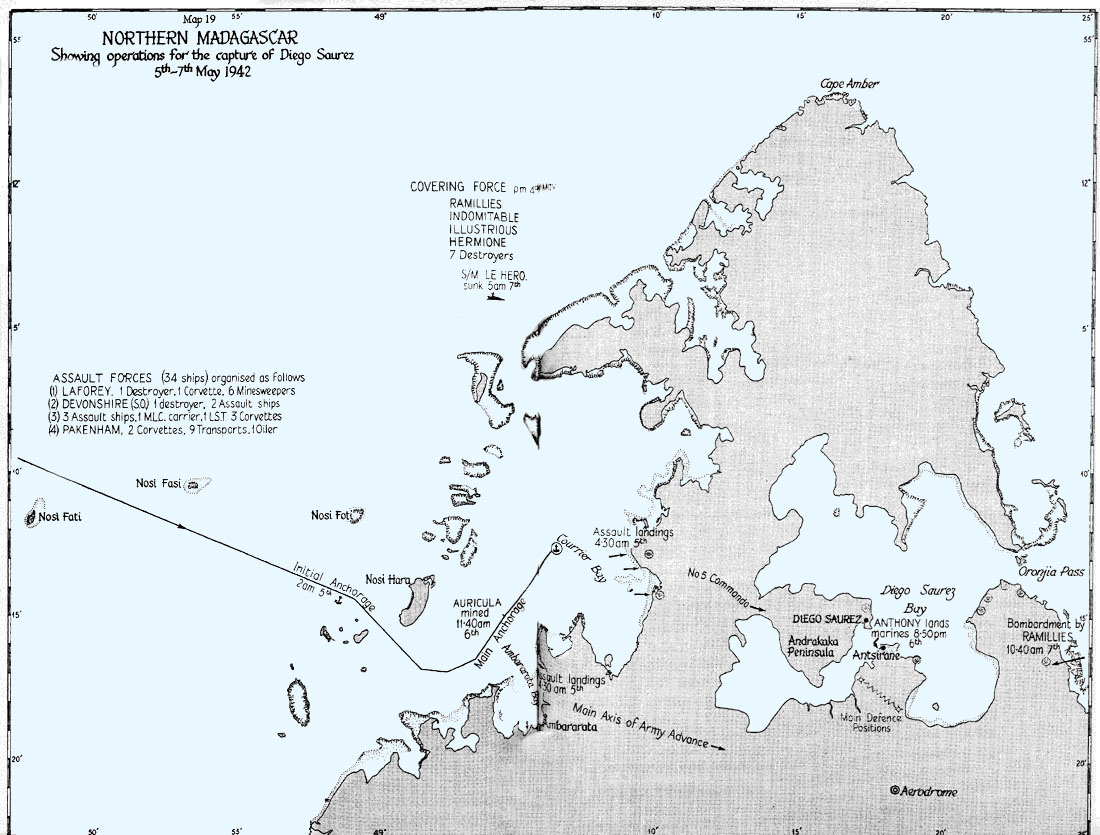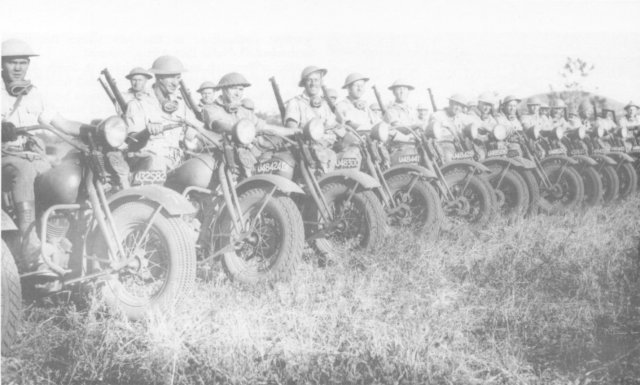Here is some more interesting information about the UDF's HarleyDavidson's in the Battle of Madagascar during the Second World War.
Japan's entry to the second World War in December 1941 and the startling success of her forces in South East Asia and the Indian Ocean suddenly increased the strategic importance of the Vichy-held French colony of Madagascar. Allied Planners were of the opinion that it was just a matter of time before Japan would occupy the Island and thereby gain control over the vital shipping routes around the Cape.
 |
| Madagascar was crucially important to the Allied Forces (Source The National WWII Museum, New Orleans) |
The Battle of Madagascar was the British campaign to capture Vichy French-controlled Madagascar during World War II. It began with Operation Ironclad, the seizure of the port of Diego Suarez near the northern tip of the island, on 5 May 1942.
THE IMPORTANCE OF MADAGASCAR
The Allies had heard the rumours of Japanese plans for the Indian Ocean and on 27 November 1941, the British Chiefs of Staff discussed the possibility that the Vichy government might cede the whole of Madagascar to Japan, or alternatively permit the Japanese navy to establish bases on the island. British naval advisers urged the occupation of the island as a precautionary measure. On 16 December, General Charles de Gaulle, leader of the Free French in London, sent a letter to the British Prime Minister, Winston Churchill, in which he also urged a Free French operation against Madagascar. Churchill recognised the risk of a Japanese-controlled Madagascar to Indian Ocean shipping, particularly to the important sea route to India and Ceylon, (now Sri Lanka) and considered the port of Diego Suarez as the strategic key to Japanese influence in the Indian Ocean.
PREPARING FOR THE BATTLE OF MADAGASCAR
By 12 March 1942, Churchill had been convinced of the importance of such an operation and the decision was reached that the planning of the invasion of Madagascar would begin in earnest.
On 14 March, "Force 121" was constituted under the command of Major-General Robert Sturges of the Royal Marines with Rear-Admiral Edward Syfret being placed in command of Naval Force H and the supporting sea force.
Force 121 left the Clyde in Scotland on 23 March 1942 and joined up with Admiral Syfret's ships at Freetown in Sierra Leone, proceeding from there in two convoys to their assembly point at Durban on the South African east coast. Here they were joined by the 13th Brigade Group of the 5th Division – General Sturges' force consisting of three infantry brigades, while Admiral Syfret's squadron consisted of the flag battleship HMS Ramillies, the aircraft carriers HMS Illustrious and HMS Indomitable, the cruisers HMS Hermione and HMS Devonshire, eleven destroyers, six minesweepers, six corvettes and auxiliaries. It was a formidable force to bring against the 8,000 men (mostly Malagasy) at Diego Suarez, but the Chiefs of Staff were adamant that the operation was to succeed, preferably without any fighting.
In March and April, the South African Air Force (SAAF) had conducted reconnaissance flights over Diego Suarez and No. 32, 36 and 37 Coastal Flights were withdrawn from maritime patrol operations and sent to Lindi on the Indian Ocean coast of Tanganyika, with an additional eleven Bristol Beauforts and six Martin Marylands to provide close air support during the planned operations.
THE BATTLE OF MADAGASCAR
Allied commanders decided to launch an amphibious assault on Madagascar. The task was Operation Ironclad and executed by Force 121; it would comprise allied naval, land and air forces and be commanded by Major-General Robert Sturges of the Royal Marines. The British Army landing force comprised 29th Independent Infantry Brigade Group, No 5 (Army) Commando and two brigades of the 5th Infantry Division, the latter en route to India with the remainder of their division. The Allied naval contingent consisted of over 50 vessels, drawn from Force H, the British Home Fleet and the British Eastern Fleet, commanded by Rear Admiral Edward Neville Syfret. The fleet included the aircraft carrier Illustrious, her sister ship Indomitable and the ageing battleship Ramillies to cover the landings.
 |
| Northern Madagascar, Showing Operations for the Capture of Diego Sourez, 5th-7th May 1942 (Wikipedia) |
Following many reconnaissance missions by the SAAF, the first wave of the British 29th Infantry Brigade and No. 5 Commando landed in assault craft on 5 May 1942, follow-up waves were by two brigades of the 5th Infantry Division and Royal Marines. All were carried ashore by landing craft to Courrier Bay and Ambararata Bay, just west of the major port of Diego Suarez (later known as Antsiranana), at the northern tip of Madagascar. A diversionary attack was staged to the east. Air cover was provided mainly by Fairey Albacore and Fairey Swordfish torpedo bombers which attacked Vichy shipping. They were supported by Grumman Martlets (known by the Americans as the F4F Wildcat) fighters from the Fleet Air Arm. A small number of SAAF planes assisted.
The defending Vichy forces, led by Governor General Armand Léon Annet, included about 8,000 troops, of whom about 6,000 were Malagasy tirailleurs (colonial infantry). A large proportion of the rest were Senegalese. Between 1,500 and 3,000 Vichy troops were concentrated around Diego Suarez. However, naval and air defences were relatively light and/or obsolete: eight coastal batteries, two armed merchant cruisers, two sloops, five submarines, 17 Morane-Saulnier 406 fighters and 10 Potez 63 bombers.
The French defence was highly effective in the beginning and the main Allied force was brought to a halt by the morning of 6 May. The deadlock was broken when the old destroyer HMS Anthony dashed straight past the harbour defences of Diego Suarez and landed 50 Royal Marines amidst the Vichy rear area. The Marines created "disturbance in the town out of all proportion to their numbers" and the Vichy defence was soon broken. Diego Suarez was surrendered on 7 May, although substantial Vichy forces withdrew to the south.
THE GROUND CAMPAIGN
Hostilities continued at a low level for several months. After 19 May 1942 two brigades of the 5th Infantry Division were transferred to India. On 8 June, the 22nd (East Africa) Brigade Group arrived on Madagascar. The 7th South African Motorised Brigade, comprising infantrymen, armoured cars and motorcycles (Harley-Davidson’s) arrived on 24 June 1942. The 27th (North Rhodesia) Infantry Brigade (including forces from East Africa) landed on 8 August.
 |
|
A
demonstration of 750cc (5/7) UDF Harley-Davidson's during the campaign in
Madagascar, June 1942
|
On 10 September 1942 the 29th Brigade and 22nd Brigade Group made an amphibious landing at Majunga, in the northwest, to re-launch Allied offencive operations ahead of the rainy season. Progress was slow for the Allied forces though.
In the fighting on Madagascar, the UDF (SA) armoured cars and accompanying motorcycles were often in the lead and battled against the enemy on mountainous forested terrain, at times in heavy rains and again on atrocious roads. There were road blocks, machine guns, snipers and blown bridges to contend with, compounded by outbreaks of malaria which infected half the soldiers.
 |
| South Africa Armoured Cars on Patrol in Madagascar, Scientia Militaria |
The Allies eventually captured the capital, Tananarive, without much opposition, and then the town of Ambalavao. The last major action was at Andramanalina on 18 October. An armistice was signed in Ambalavao on 6 November, and Annet surrendered near Ihosy, in the south of the island, on 8 November 1942.
HAND-OVER TO FREE FRENCH
It was never the intention of the British to permanently occupy the Island. Within a couple of months after the completion of the military objectives, the control of the Island ws handed over to the Free French led by General Charles de Gualle. De Gaulle appointed General Legentilhomme as the High Commissioner of the Island.RETURN TO SOUTH AFRICA
The UDF (SA) Forces in Madagascar were shipped back to South Africa soon after the hand-over to the Free French.WHAT HAPPENED TO THE HARLEY-DAVIDSON's?
Upon returning to South Africa, the trail of the Harley-Davidson's in the UDF (SA) disappears. After reading up on the North Africa Campaign, as well as, the Italian Campaign I have come to the following conclusion:- The UDF (SA) lost a large contingent of its forces, vehicles and motorcycles when Field Marshall Rommel overran their positions in North Africa. A total of 17,000 South Africans were taken as Prisoners of War (POW's), of which around 550 were from the Armoured Car Units to which the Harley-Davidson Motorcycle Companies were attached.
- It is therefore reasonable to assume that their vehicles and motorcycles were either destroyed or confiscated and shipped back to Germany. [I'll try to see if I can find information from German War Records whether any Harley-Davidsons were shipped back to Germany.]
- Some of the POW's were shipped to Europe, but the Allied Forces escalated their campaign against Field Marshall Rommel by opening up two fronts - one from Egypt and the other from the Western Sahara. At the same time they stepped up shipping patrols in the Mediterranean to restrict the German supply lines to North Africa. This eventually led to the retreat of the Afrika Korps and the remains of the Afrika Korps were extracted back to Europe by the German High Command.
- The South African POW's in North Africa were repatriated back to South Africa, where the UDF decided that they would rather convert the Infantry Battalions to Armoured Divisions. As a result of this, the 6th South African Armoured Division was formed in February 1943 and staffed with the troops that returned from the North Africa and the Madagascar Campaigns.
- I suspect that the Harley-Davidson's were re-assigned to Signal Units to be used by dispatch riders. [I will try to see if I can get any evidence to support this assumption.]
SOURCES
The sources for this information were:- Scientia Militaria: South African Journal of Military Studies, "Die Gallieerde Besetting van Madagaskar in 1941 (Deel I tot V)", Vol 7 No 4; Vol 8 No 1 to 4 of 1977 and 1978.
- Photo from Scientia Militaria: South African Journal of Military Studies, "Die Gallieerde Besetting van Madagaskar in 1941 (Deel III)", Vol 8 No 2, 1978.
- Harley's in Khaki;
- The Battle of Madagascar.
No comments:
Post a Comment